Community Assessment Report docx.
VerifiedAdded on 2022/08/21
|6
|1531
|12
AI Summary
Contribute Materials
Your contribution can guide someone’s learning journey. Share your
documents today.
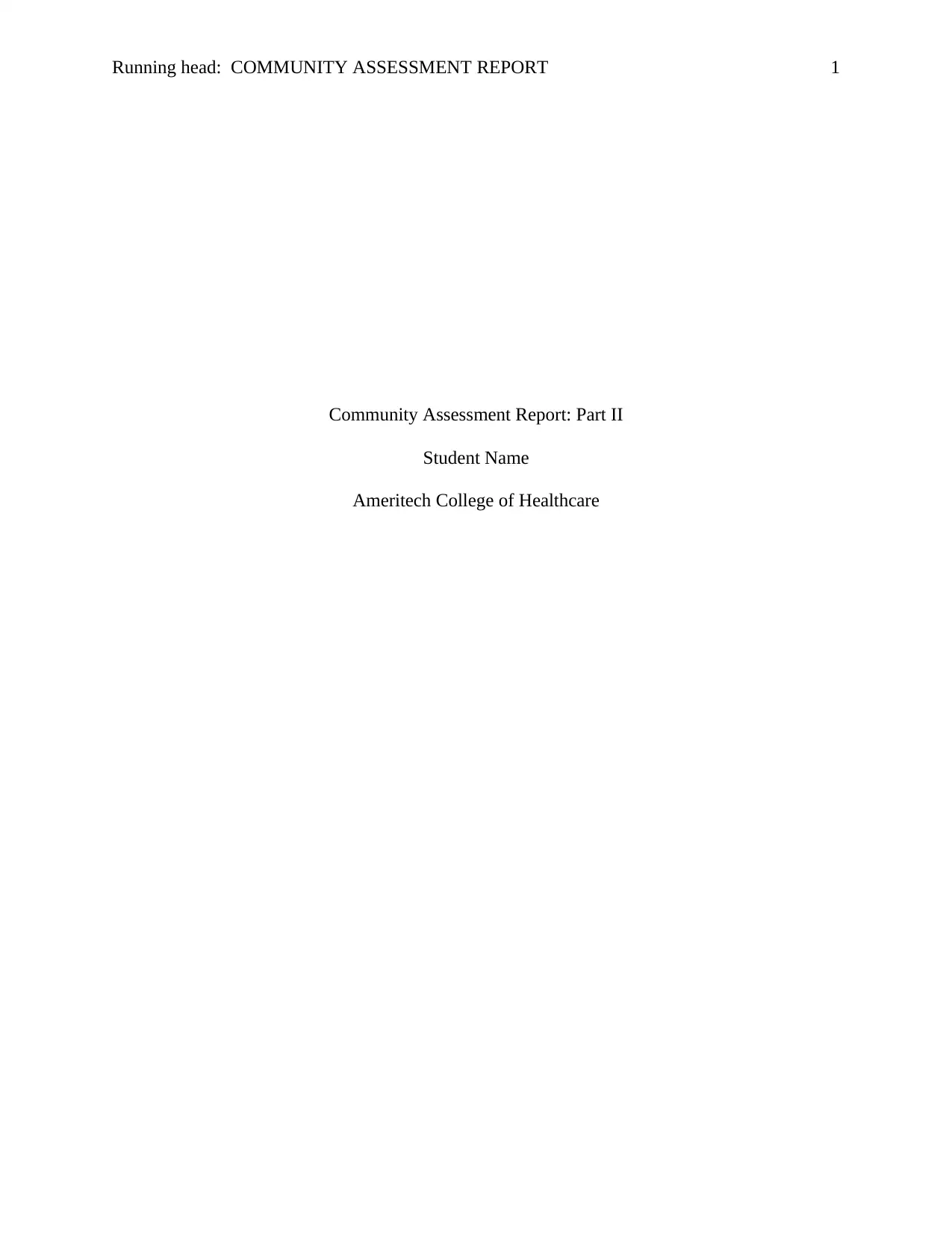
Running head: COMMUNITY ASSESSMENT REPORT 1
Community Assessment Report: Part II
Student Name
Ameritech College of Healthcare
Community Assessment Report: Part II
Student Name
Ameritech College of Healthcare
Secure Best Marks with AI Grader
Need help grading? Try our AI Grader for instant feedback on your assignments.
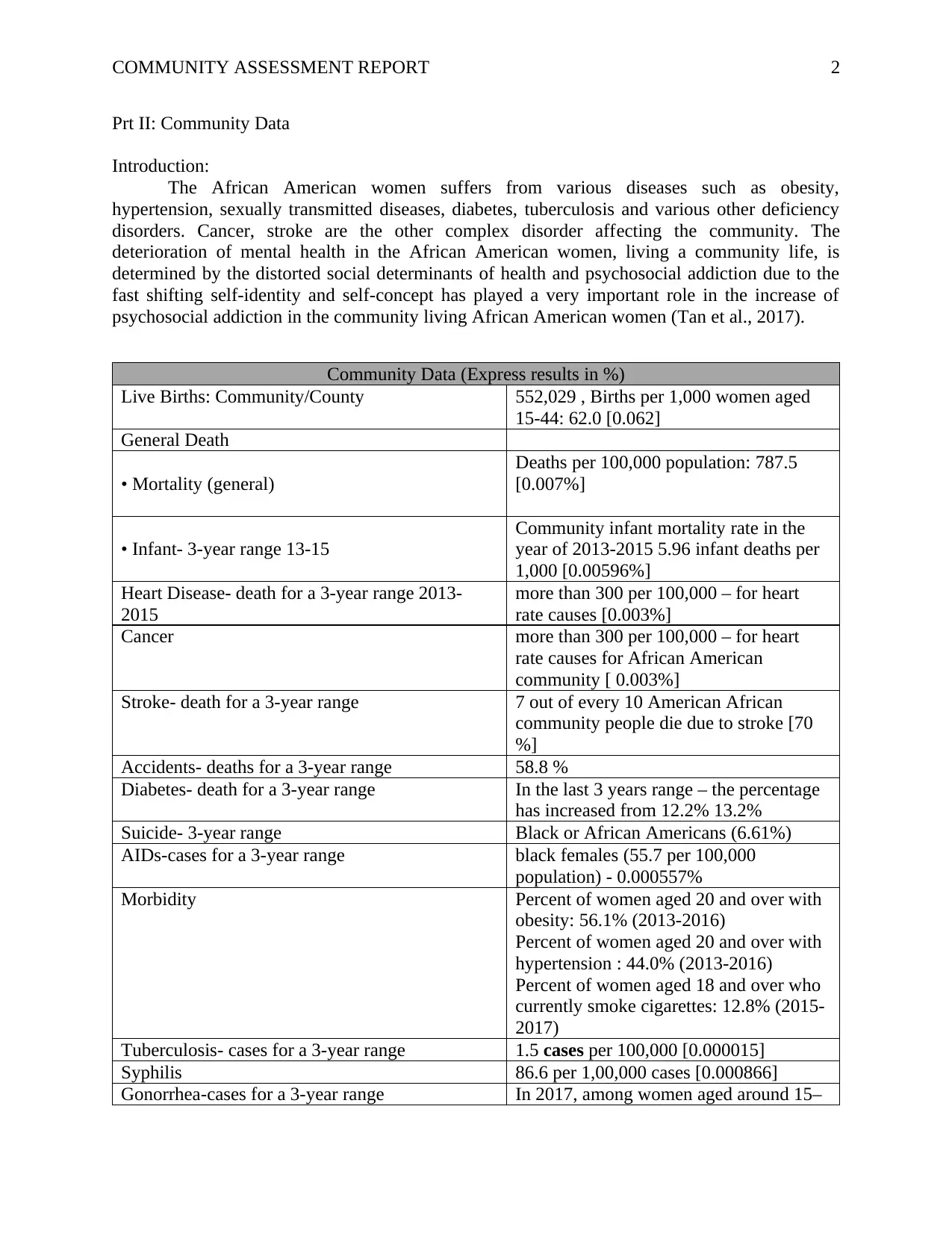
COMMUNITY ASSESSMENT REPORT 2
Prt II: Community Data
Introduction:
The African American women suffers from various diseases such as obesity,
hypertension, sexually transmitted diseases, diabetes, tuberculosis and various other deficiency
disorders. Cancer, stroke are the other complex disorder affecting the community. The
deterioration of mental health in the African American women, living a community life, is
determined by the distorted social determinants of health and psychosocial addiction due to the
fast shifting self-identity and self-concept has played a very important role in the increase of
psychosocial addiction in the community living African American women (Tan et al., 2017).
Community Data (Express results in %)
Live Births: Community/County 552,029 , Births per 1,000 women aged
15-44: 62.0 [0.062]
General Death
• Mortality (general)
Deaths per 100,000 population: 787.5
[0.007%]
• Infant- 3-year range 13-15
Community infant mortality rate in the
year of 2013-2015 5.96 infant deaths per
1,000 [0.00596%]
Heart Disease- death for a 3-year range 2013-
2015
more than 300 per 100,000 – for heart
rate causes [0.003%]
Cancer more than 300 per 100,000 – for heart
rate causes for African American
community [ 0.003%]
Stroke- death for a 3-year range 7 out of every 10 American African
community people die due to stroke [70
%]
Accidents- deaths for a 3-year range 58.8 %
Diabetes- death for a 3-year range In the last 3 years range – the percentage
has increased from 12.2% 13.2%
Suicide- 3-year range Black or African Americans (6.61%)
AIDs-cases for a 3-year range black females (55.7 per 100,000
population) - 0.000557%
Morbidity Percent of women aged 20 and over with
obesity: 56.1% (2013-2016)
Percent of women aged 20 and over with
hypertension : 44.0% (2013-2016)
Percent of women aged 18 and over who
currently smoke cigarettes: 12.8% (2015-
2017)
Tuberculosis- cases for a 3-year range 1.5 cases per 100,000 [0.000015]
Syphilis 86.6 per 1,00,000 cases [0.000866]
Gonorrhea-cases for a 3-year range In 2017, among women aged around 15–
Prt II: Community Data
Introduction:
The African American women suffers from various diseases such as obesity,
hypertension, sexually transmitted diseases, diabetes, tuberculosis and various other deficiency
disorders. Cancer, stroke are the other complex disorder affecting the community. The
deterioration of mental health in the African American women, living a community life, is
determined by the distorted social determinants of health and psychosocial addiction due to the
fast shifting self-identity and self-concept has played a very important role in the increase of
psychosocial addiction in the community living African American women (Tan et al., 2017).
Community Data (Express results in %)
Live Births: Community/County 552,029 , Births per 1,000 women aged
15-44: 62.0 [0.062]
General Death
• Mortality (general)
Deaths per 100,000 population: 787.5
[0.007%]
• Infant- 3-year range 13-15
Community infant mortality rate in the
year of 2013-2015 5.96 infant deaths per
1,000 [0.00596%]
Heart Disease- death for a 3-year range 2013-
2015
more than 300 per 100,000 – for heart
rate causes [0.003%]
Cancer more than 300 per 100,000 – for heart
rate causes for African American
community [ 0.003%]
Stroke- death for a 3-year range 7 out of every 10 American African
community people die due to stroke [70
%]
Accidents- deaths for a 3-year range 58.8 %
Diabetes- death for a 3-year range In the last 3 years range – the percentage
has increased from 12.2% 13.2%
Suicide- 3-year range Black or African Americans (6.61%)
AIDs-cases for a 3-year range black females (55.7 per 100,000
population) - 0.000557%
Morbidity Percent of women aged 20 and over with
obesity: 56.1% (2013-2016)
Percent of women aged 20 and over with
hypertension : 44.0% (2013-2016)
Percent of women aged 18 and over who
currently smoke cigarettes: 12.8% (2015-
2017)
Tuberculosis- cases for a 3-year range 1.5 cases per 100,000 [0.000015]
Syphilis 86.6 per 1,00,000 cases [0.000866]
Gonorrhea-cases for a 3-year range In 2017, among women aged around 15–
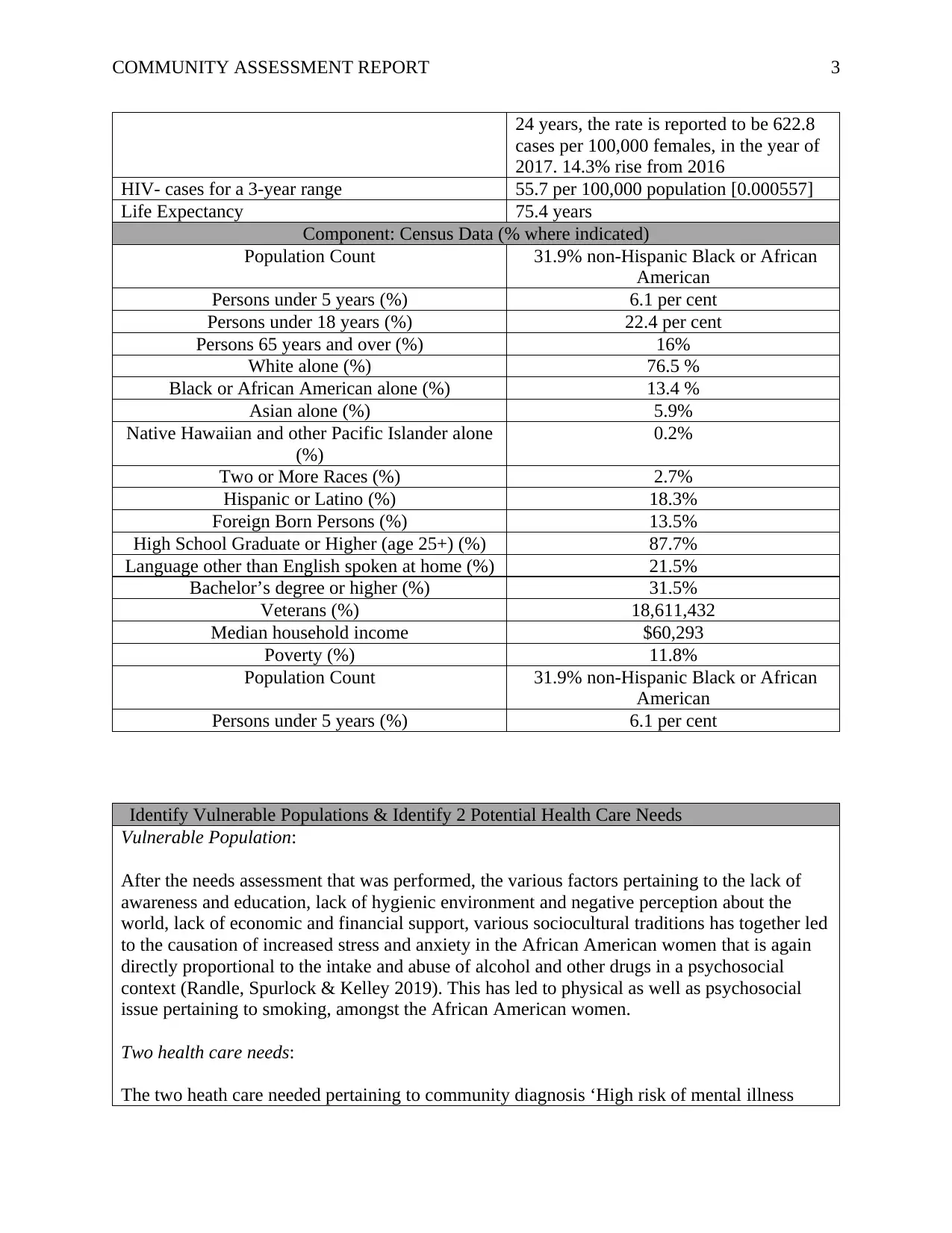
COMMUNITY ASSESSMENT REPORT 3
24 years, the rate is reported to be 622.8
cases per 100,000 females, in the year of
2017. 14.3% rise from 2016
HIV- cases for a 3-year range 55.7 per 100,000 population [0.000557]
Life Expectancy 75.4 years
Component: Census Data (% where indicated)
Population Count 31.9% non-Hispanic Black or African
American
Persons under 5 years (%) 6.1 per cent
Persons under 18 years (%) 22.4 per cent
Persons 65 years and over (%) 16%
White alone (%) 76.5 %
Black or African American alone (%) 13.4 %
Asian alone (%) 5.9%
Native Hawaiian and other Pacific Islander alone
(%)
0.2%
Two or More Races (%) 2.7%
Hispanic or Latino (%) 18.3%
Foreign Born Persons (%) 13.5%
High School Graduate or Higher (age 25+) (%) 87.7%
Language other than English spoken at home (%) 21.5%
Bachelor’s degree or higher (%) 31.5%
Veterans (%) 18,611,432
Median household income $60,293
Poverty (%) 11.8%
Population Count 31.9% non-Hispanic Black or African
American
Persons under 5 years (%) 6.1 per cent
Identify Vulnerable Populations & Identify 2 Potential Health Care Needs
Vulnerable Population:
After the needs assessment that was performed, the various factors pertaining to the lack of
awareness and education, lack of hygienic environment and negative perception about the
world, lack of economic and financial support, various sociocultural traditions has together led
to the causation of increased stress and anxiety in the African American women that is again
directly proportional to the intake and abuse of alcohol and other drugs in a psychosocial
context (Randle, Spurlock & Kelley 2019). This has led to physical as well as psychosocial
issue pertaining to smoking, amongst the African American women.
Two health care needs:
The two heath care needed pertaining to community diagnosis ‘High risk of mental illness
24 years, the rate is reported to be 622.8
cases per 100,000 females, in the year of
2017. 14.3% rise from 2016
HIV- cases for a 3-year range 55.7 per 100,000 population [0.000557]
Life Expectancy 75.4 years
Component: Census Data (% where indicated)
Population Count 31.9% non-Hispanic Black or African
American
Persons under 5 years (%) 6.1 per cent
Persons under 18 years (%) 22.4 per cent
Persons 65 years and over (%) 16%
White alone (%) 76.5 %
Black or African American alone (%) 13.4 %
Asian alone (%) 5.9%
Native Hawaiian and other Pacific Islander alone
(%)
0.2%
Two or More Races (%) 2.7%
Hispanic or Latino (%) 18.3%
Foreign Born Persons (%) 13.5%
High School Graduate or Higher (age 25+) (%) 87.7%
Language other than English spoken at home (%) 21.5%
Bachelor’s degree or higher (%) 31.5%
Veterans (%) 18,611,432
Median household income $60,293
Poverty (%) 11.8%
Population Count 31.9% non-Hispanic Black or African
American
Persons under 5 years (%) 6.1 per cent
Identify Vulnerable Populations & Identify 2 Potential Health Care Needs
Vulnerable Population:
After the needs assessment that was performed, the various factors pertaining to the lack of
awareness and education, lack of hygienic environment and negative perception about the
world, lack of economic and financial support, various sociocultural traditions has together led
to the causation of increased stress and anxiety in the African American women that is again
directly proportional to the intake and abuse of alcohol and other drugs in a psychosocial
context (Randle, Spurlock & Kelley 2019). This has led to physical as well as psychosocial
issue pertaining to smoking, amongst the African American women.
Two health care needs:
The two heath care needed pertaining to community diagnosis ‘High risk of mental illness
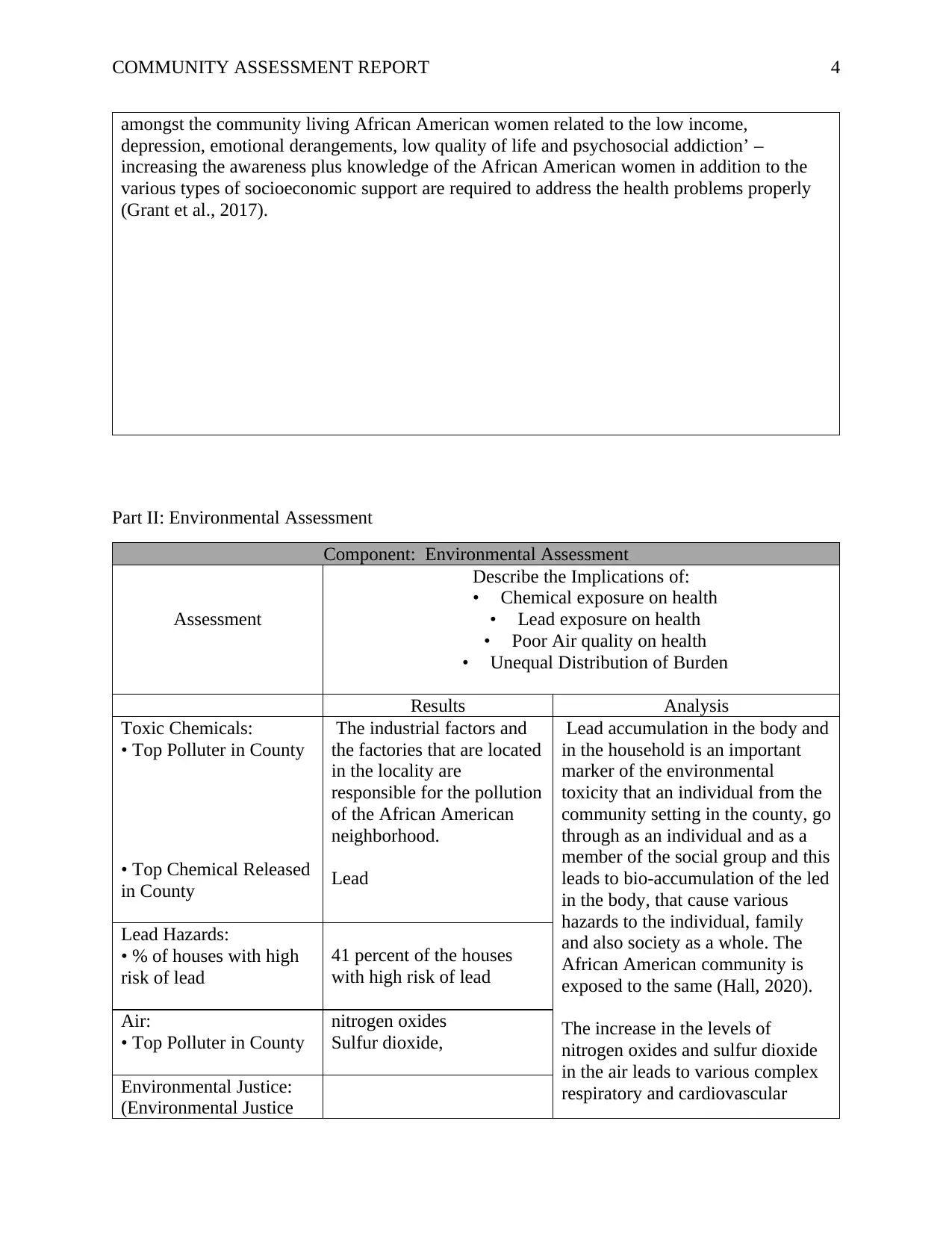
COMMUNITY ASSESSMENT REPORT 4
amongst the community living African American women related to the low income,
depression, emotional derangements, low quality of life and psychosocial addiction’ –
increasing the awareness plus knowledge of the African American women in addition to the
various types of socioeconomic support are required to address the health problems properly
(Grant et al., 2017).
Part II: Environmental Assessment
Component: Environmental Assessment
Assessment
Describe the Implications of:
• Chemical exposure on health
• Lead exposure on health
• Poor Air quality on health
• Unequal Distribution of Burden
Results Analysis
Toxic Chemicals:
• Top Polluter in County
• Top Chemical Released
in County
The industrial factors and
the factories that are located
in the locality are
responsible for the pollution
of the African American
neighborhood.
Lead
Lead accumulation in the body and
in the household is an important
marker of the environmental
toxicity that an individual from the
community setting in the county, go
through as an individual and as a
member of the social group and this
leads to bio-accumulation of the led
in the body, that cause various
hazards to the individual, family
and also society as a whole. The
African American community is
exposed to the same (Hall, 2020).
The increase in the levels of
nitrogen oxides and sulfur dioxide
in the air leads to various complex
respiratory and cardiovascular
Lead Hazards:
• % of houses with high
risk of lead
41 percent of the houses
with high risk of lead
Air:
• Top Polluter in County
nitrogen oxides
Sulfur dioxide,
Environmental Justice:
(Environmental Justice
amongst the community living African American women related to the low income,
depression, emotional derangements, low quality of life and psychosocial addiction’ –
increasing the awareness plus knowledge of the African American women in addition to the
various types of socioeconomic support are required to address the health problems properly
(Grant et al., 2017).
Part II: Environmental Assessment
Component: Environmental Assessment
Assessment
Describe the Implications of:
• Chemical exposure on health
• Lead exposure on health
• Poor Air quality on health
• Unequal Distribution of Burden
Results Analysis
Toxic Chemicals:
• Top Polluter in County
• Top Chemical Released
in County
The industrial factors and
the factories that are located
in the locality are
responsible for the pollution
of the African American
neighborhood.
Lead
Lead accumulation in the body and
in the household is an important
marker of the environmental
toxicity that an individual from the
community setting in the county, go
through as an individual and as a
member of the social group and this
leads to bio-accumulation of the led
in the body, that cause various
hazards to the individual, family
and also society as a whole. The
African American community is
exposed to the same (Hall, 2020).
The increase in the levels of
nitrogen oxides and sulfur dioxide
in the air leads to various complex
respiratory and cardiovascular
Lead Hazards:
• % of houses with high
risk of lead
41 percent of the houses
with high risk of lead
Air:
• Top Polluter in County
nitrogen oxides
Sulfur dioxide,
Environmental Justice:
(Environmental Justice
Secure Best Marks with AI Grader
Need help grading? Try our AI Grader for instant feedback on your assignments.
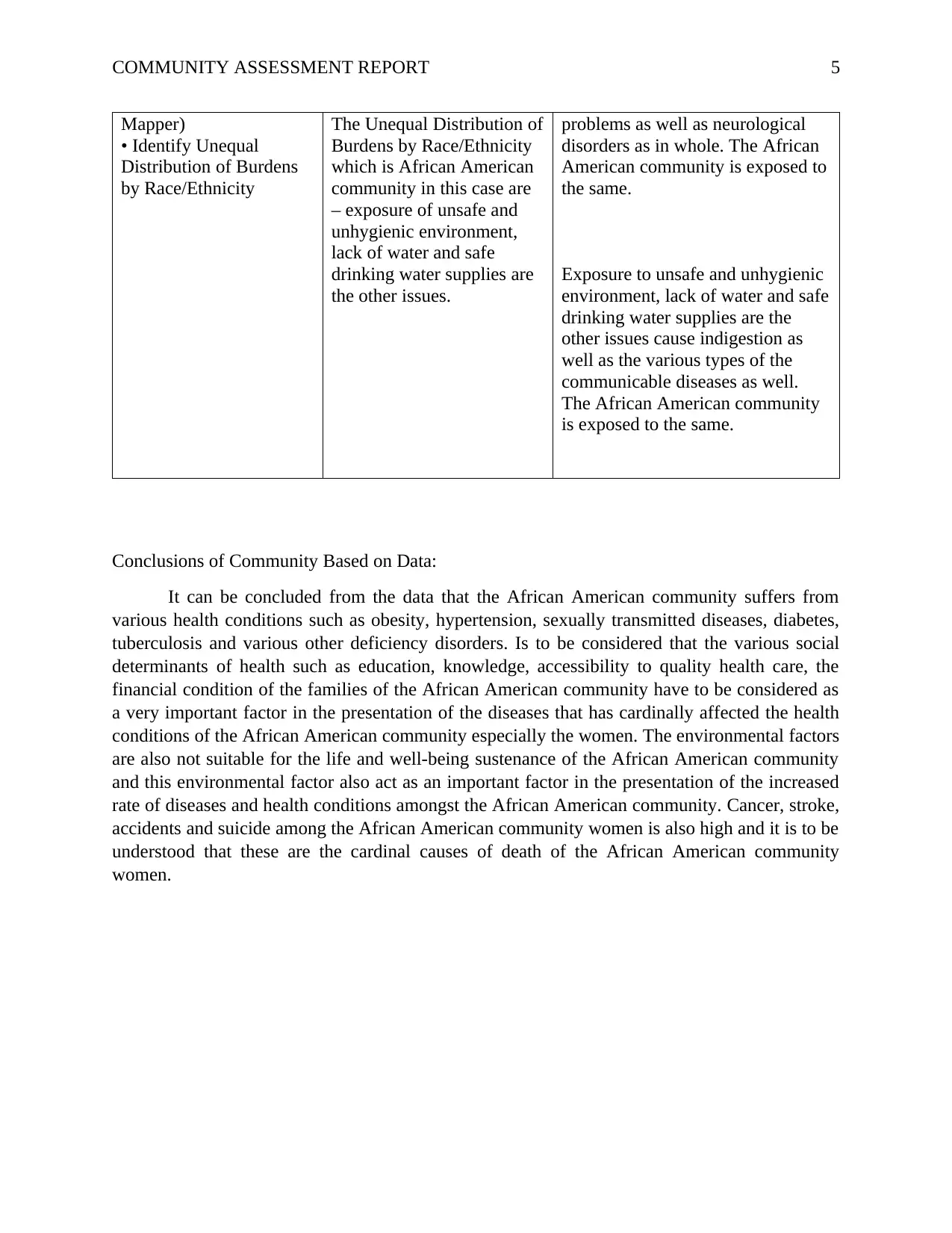
COMMUNITY ASSESSMENT REPORT 5
Mapper)
• Identify Unequal
Distribution of Burdens
by Race/Ethnicity
The Unequal Distribution of
Burdens by Race/Ethnicity
which is African American
community in this case are
– exposure of unsafe and
unhygienic environment,
lack of water and safe
drinking water supplies are
the other issues.
problems as well as neurological
disorders as in whole. The African
American community is exposed to
the same.
Exposure to unsafe and unhygienic
environment, lack of water and safe
drinking water supplies are the
other issues cause indigestion as
well as the various types of the
communicable diseases as well.
The African American community
is exposed to the same.
Conclusions of Community Based on Data:
It can be concluded from the data that the African American community suffers from
various health conditions such as obesity, hypertension, sexually transmitted diseases, diabetes,
tuberculosis and various other deficiency disorders. Is to be considered that the various social
determinants of health such as education, knowledge, accessibility to quality health care, the
financial condition of the families of the African American community have to be considered as
a very important factor in the presentation of the diseases that has cardinally affected the health
conditions of the African American community especially the women. The environmental factors
are also not suitable for the life and well-being sustenance of the African American community
and this environmental factor also act as an important factor in the presentation of the increased
rate of diseases and health conditions amongst the African American community. Cancer, stroke,
accidents and suicide among the African American community women is also high and it is to be
understood that these are the cardinal causes of death of the African American community
women.
Mapper)
• Identify Unequal
Distribution of Burdens
by Race/Ethnicity
The Unequal Distribution of
Burdens by Race/Ethnicity
which is African American
community in this case are
– exposure of unsafe and
unhygienic environment,
lack of water and safe
drinking water supplies are
the other issues.
problems as well as neurological
disorders as in whole. The African
American community is exposed to
the same.
Exposure to unsafe and unhygienic
environment, lack of water and safe
drinking water supplies are the
other issues cause indigestion as
well as the various types of the
communicable diseases as well.
The African American community
is exposed to the same.
Conclusions of Community Based on Data:
It can be concluded from the data that the African American community suffers from
various health conditions such as obesity, hypertension, sexually transmitted diseases, diabetes,
tuberculosis and various other deficiency disorders. Is to be considered that the various social
determinants of health such as education, knowledge, accessibility to quality health care, the
financial condition of the families of the African American community have to be considered as
a very important factor in the presentation of the diseases that has cardinally affected the health
conditions of the African American community especially the women. The environmental factors
are also not suitable for the life and well-being sustenance of the African American community
and this environmental factor also act as an important factor in the presentation of the increased
rate of diseases and health conditions amongst the African American community. Cancer, stroke,
accidents and suicide among the African American community women is also high and it is to be
understood that these are the cardinal causes of death of the African American community
women.
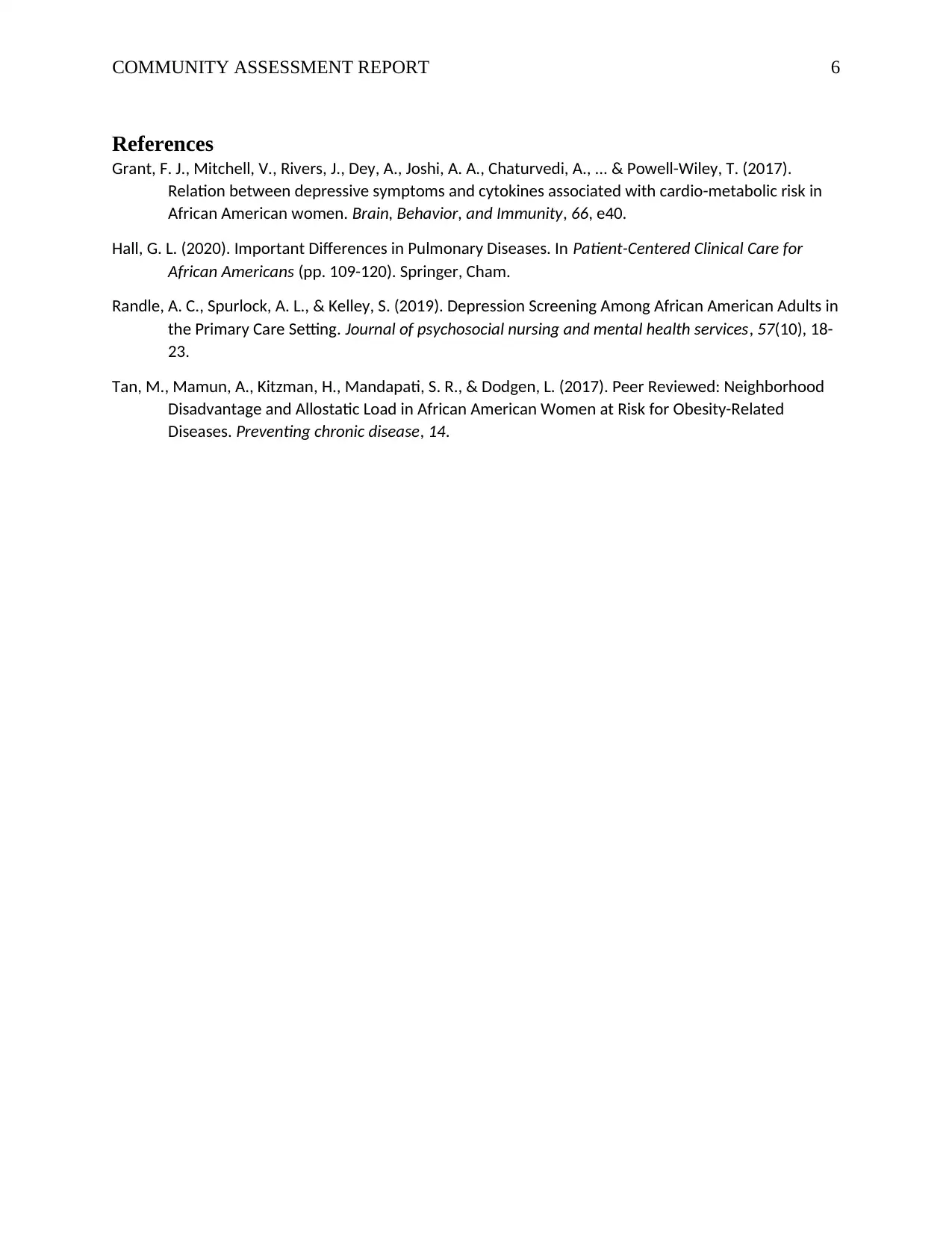
COMMUNITY ASSESSMENT REPORT 6
References
Grant, F. J., Mitchell, V., Rivers, J., Dey, A., Joshi, A. A., Chaturvedi, A., ... & Powell-Wiley, T. (2017).
Relation between depressive symptoms and cytokines associated with cardio-metabolic risk in
African American women. Brain, Behavior, and Immunity, 66, e40.
Hall, G. L. (2020). Important Differences in Pulmonary Diseases. In Patient-Centered Clinical Care for
African Americans (pp. 109-120). Springer, Cham.
Randle, A. C., Spurlock, A. L., & Kelley, S. (2019). Depression Screening Among African American Adults in
the Primary Care Setting. Journal of psychosocial nursing and mental health services, 57(10), 18-
23.
Tan, M., Mamun, A., Kitzman, H., Mandapati, S. R., & Dodgen, L. (2017). Peer Reviewed: Neighborhood
Disadvantage and Allostatic Load in African American Women at Risk for Obesity-Related
Diseases. Preventing chronic disease, 14.
References
Grant, F. J., Mitchell, V., Rivers, J., Dey, A., Joshi, A. A., Chaturvedi, A., ... & Powell-Wiley, T. (2017).
Relation between depressive symptoms and cytokines associated with cardio-metabolic risk in
African American women. Brain, Behavior, and Immunity, 66, e40.
Hall, G. L. (2020). Important Differences in Pulmonary Diseases. In Patient-Centered Clinical Care for
African Americans (pp. 109-120). Springer, Cham.
Randle, A. C., Spurlock, A. L., & Kelley, S. (2019). Depression Screening Among African American Adults in
the Primary Care Setting. Journal of psychosocial nursing and mental health services, 57(10), 18-
23.
Tan, M., Mamun, A., Kitzman, H., Mandapati, S. R., & Dodgen, L. (2017). Peer Reviewed: Neighborhood
Disadvantage and Allostatic Load in African American Women at Risk for Obesity-Related
Diseases. Preventing chronic disease, 14.
1 out of 6
Related Documents
Your All-in-One AI-Powered Toolkit for Academic Success.
+13062052269
info@desklib.com
Available 24*7 on WhatsApp / Email
![[object Object]](/_next/static/media/star-bottom.7253800d.svg)
Unlock your academic potential
© 2024 | Zucol Services PVT LTD | All rights reserved.




